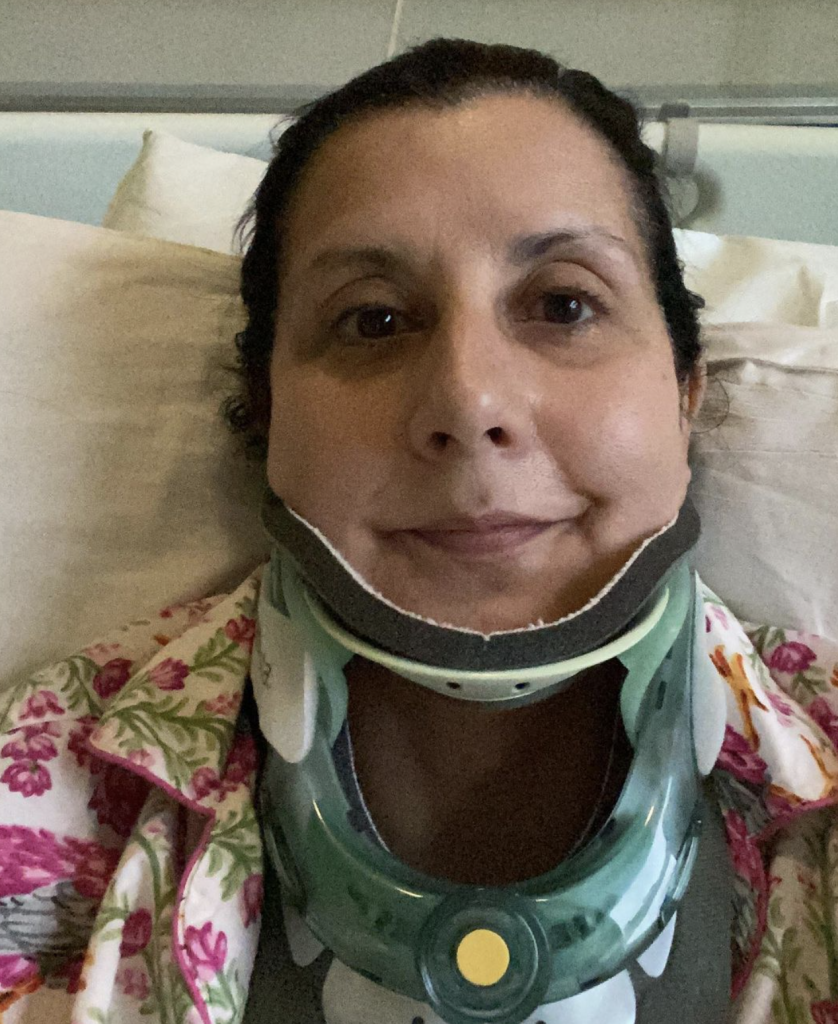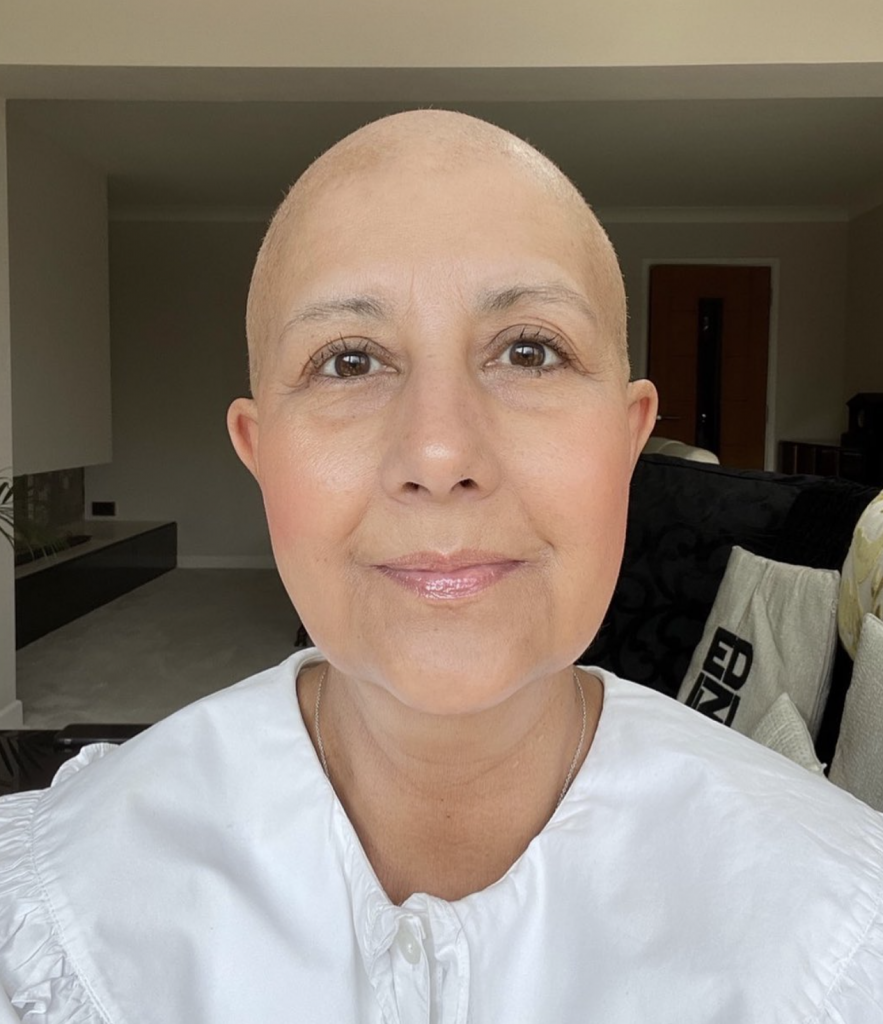A 'Baffling' Diagnosis - Multiple Myeloma
- Esther Shoebridge, 59, was experiencing numerous “baffling” symptoms, including what she describes as an “unquenchable” thirst, which ultimately wound up being the first sign of her blood cancer diagnosis.
- The mother and grandmother had also been losing weight, then after being unable to hold her neck up, learned it was broken due to tumors on her vertebrae.
- Multiple myeloma is a rare type of blood cancer that occurs when white blood cells in your bone marrow grow out of proportion. Though this type of cancer is incurable, there are newly-approved promising treatments to help patients who relapse from the disease. SurvivorNet has put together an overview on this complicated disease to help guide you through.
The mother and grandmother, who is from Yorkshire in northeastern England, said that her doctor then discovered “millions of holes” and tumors in her body.
Read More
“Two small tumors had blasted their way through my vertebrae – I couldn’t lift a thing. I couldn’t even lift my own kettle,” Ester said, noting that she “used to go to the gym and be very fit.”
Esther had gone to see two different doctors – as she was holding her neck up all the time and often lying down to rest it – but they “just gave me painkillers.”
She had also started losing weight, which can be a symptoms of many different illnesses, but can often be one of the signs of cancer, depending on the type and stage.
However, the main symptom that alerted her was the excessive thirst. “I was thirsty every single minute, despite drinking so much water. It was completely out of the blue.”
A Multiple Myeloma Diagnosis
Then in 2021, Esther suddenly felt numbness in her face and immediately went to the emergency room. One month later, she received her official diagnosis: Myeloma, which is also known as multiple myeloma.
Tragically, her chemotherapy treatment was not successful and the disease, so far, has come back twice, which is unfortunately common for this disease.

Though her prognosis given by her medical team is not favorable, she refuses to give in to the disease and allow a time stamp on her life.
“I’m not accepting that. I’m small but I’m tough,” she said. “I go out and walk whatever the weather and yes, my back aches but I keep fighting, I’ve got to. I’m not taking notice of how long they told me I’ll live.”

Added Esther, “I have lots still to do and too much fun to have with my husband, family, bestie and friends.”
What Is Multiple Myeloma?
Multiple myeloma is a rare type of blood cancer.
When you have this cancer, white blood cells called plasma cells (the cells that make antibodies to fight infections) in your bone marrow grow out of proportion to healthy cells. Those abnormal cells leave less room for the healthy blood cells your body needs to fight infections. They can also spread to other parts of your body and cause problems with organs like your kidneys.
Hematologist and SurvivorNet advisor Dr. Nina Shah helps you understand multiple myeloma
SurvivorNet’s medical experts say people are often diagnosed with this cancer after going to their doctor seeking an answer for persistent tiredness or other unusual symptoms.
Symptoms
Here are some other signs to watch out for:
- Weakness, dizziness, and shortness of breath, which are signs of a low red blood cell count, called anemia
- Bone pain, which could be a sign of a fracture
- Peeing too much or too little, muscle cramps, nausea and vomiting, which are symptoms of kidney failure
- Confusion, which is caused by too much calcium in the blood
- Frequent infections, because you have too few white blood cells to fight them
Risk Factors
It is also important to learn some of the risk factors for this disease:
- Age. Most people with this cancer are diagnosed in their 60s, although it is possible to get multiple myeloma earlier in life.
Family history. Having a sibling, parent, or other close relative with this cancer could increase your risk. - Gender. Men are at slightly higher risk for this cancer than women.
- Race. African Americans tend to have higher rates of this disease, although it is still relatively rare. Asian Americans are least likely to get this cancer.
- Monoclonal gammopathy of undetermined significance (MGUS). This condition with the hard-to-pronounce name simply means that you have too much of an abnormal protein–called monoclonal protein–in your bone marrow and blood. MGUS is rare, and the risk that it will turn into multiple myeloma is only 1% each year.
New Hope for Relapsed Multiple Myeloma Patients
Patients like Esther living with multiple myeloma know all too well the risk of relapse.
When multiple myeloma returns after treatment, it usually means that residual cells were either resistant to the treatment from the start or developed resistance as the treatment was ongoing.
Multiple myeloma: What Precedes the Full-Blown Cancer?
At this year’s American Society of Clinical Oncology (ASCO) conference, one of the largest gatherings of leaders in the oncology world, SurvivorNet had the opportunity to speak to influential figures who help decide which treatments receive funding and support — and get an idea about the biggest advances in cancer care over the past year.
Among these influential figures was Tyrone Brewer, the U.S. president of hematology at Johnson & Johnson, a renowned leader in multiple myeloma treatment. He and his team consistently prioritize patients’ needs in their work.
“For those patients that have unfortunately been diagnosed with cancer, I want you to know that we are here to fight for you. You are our purpose. You are our drive,” Brewer shared with SurvivorNet.
Which Treatment is Right for You?
Not everyone with multiple myeloma needs treatment right away. If you have smoldering multiple myeloma, your doctor might simply monitor you regularly, to see if your disease progresses.
If you develop symptoms or your doctor thinks you need treatment, there are many options. Which of these treatments you receive and how they are sequenced can depend on several factors and on whether your treatment team thinks you are a good candidate for a bone marrow transplant.
Bone Marrow (Stem Cell) Transplant
This is also known as a stem cell transplant. It is a procedure to replace diseased bone marrow with healthy bone marrow without myeloma cells. Based on multiple factors, your doctor may decide that a stem cell transplant is best for you. The transplant process can be involved and requires multiple steps. Be sure to discuss this with your treating team to understand what is involved and what options are available.
If you’re not a good candidate for chemotherapy, your treatment options include targeted therapies, biologics, and steroids.
Targeted Therapy
Targeted therapy is now available for patients with multiple myeloma, and targets abnormalities in myeloma cells that allow the cancer to survive. Examples of targeted agents your doctor may use include bortezomib (Velcade), carfilzomib (Kyprolis), and ixazomib (Sarclisa). These drugs are either given in a pill or through an IV, and cause myeloma cells to die by preventing the breakdown of certain proteins in myeloma cells. You doctor may also use other targeted agents in the class of medications known as monoclonal antibodies.
Biologic Therapy
Biologic therapy is another class of medication your treatment team may use to treat your myeloma. These medications use your bodys immune system to help fight and kill myeloma cells. This class of medication is most often given in pill form and include medications such as thalidomide (Thalidomid), lenalidomide (Revlimid), and pomalidomide (Pomalyst).

Chemotherapy
Sometimes your treatment team may recommend chemotherapy to treat your myeloma. Chemotherapy uses strong medicine to target cancer cells throughout your body. If your doctor recommends a bone marrow transplant high doses of chemotherapy are used for this purpose.
Steroids
Occasionally, doctors may use corticosteroids such as dexamethasone or prednisone as part of your treatment. Steroids are different from chemotherapy, targeted therapy, and biologic therapy. They work to reduce inflammation throughout your body. Steroids are given as a pill, and are also active against myeloma cells.
Radiation
Radiation uses high-dose X-rays to stop cancer cells from dividing. It is sometimes used to target myeloma in specific areas that may be causing you issues or pain. It is also used if there are tumors or deposits of myeloma cells that need to be treated, such as a plasmacytoma — a tumor made of abnormal plasma cells — of the bone.
Sometimes the cancer can return, or relapse after treatment. If this happens, your doctor can put you on one of the treatments you’ve already tried again, try a new treatment, or recommend that you enroll in a clinical trial.
A Promising Immunotherapy Drug
In August, a promising immunotherapy drug called Talvey (generic name: talquetamab), which is produced by Johnson & Johnson, was approved by the U.S. Food and Drug Administration (FDA) to treat patients with multiple myeloma whose disease has returned after undergoing prior lines of treatment.
Fighting For Multiple Myeloma Patients: The Commitment From Johnson & Johnson’s Blood Cancer Leader
Talvey belongs to a class of drugs known as bispecific antibodies, a form of immunotherapy. It works by bringing cancerous myeloma cells close enough to immune cells that the immune system kills the myeloma cells.
“For patients, prior to Talvey, they really would have exhausted all of their other options, and their only hope would have been to recycle their prior regimen with the hope of having a response,” Brewer explained. “Talvey now offers them new hope because now it’s hitting a new target and the feedback we’ve gotten has been tremendous.”
Working to Improve Access for Patients in Community Hospitals
Academic healthcare centers (academic hospitals) and community centers (community hospitals) offer a standard-of-care treatment for various cancers. However, academic centers may have more resources and access to certain treatments.
The reality is that most patients are treated at community-based healthcare facilities. Brewer says Johnson & Johnson has put added focus on these critical healthcare outlets.
RELATED: Community Cancer Centers & The Importance of Access To Care
“We have additional resources that we provide to help them do either in-services and education not only around the medication but also AE (adverse event) management,” Brewer said.
Adverse events are unfavorable signs, symptoms, or diseases associated with using a specific medicine — also commonly known as side effects.
Ultimately, Brewer says he’d like to see patients get a similar standard of care at community-based hospitals as they would at more resourced academic centers.
Learn more about SurvivorNet's rigorous medical review process.





